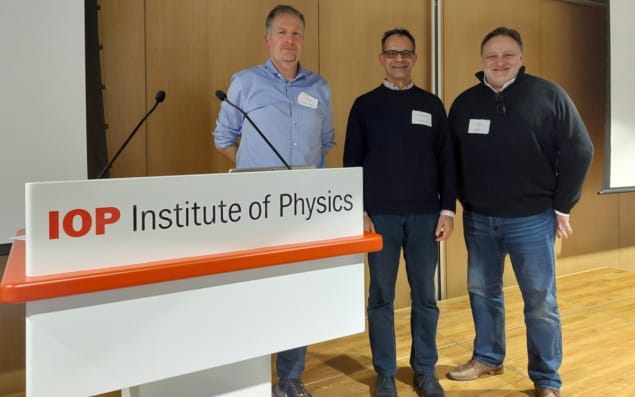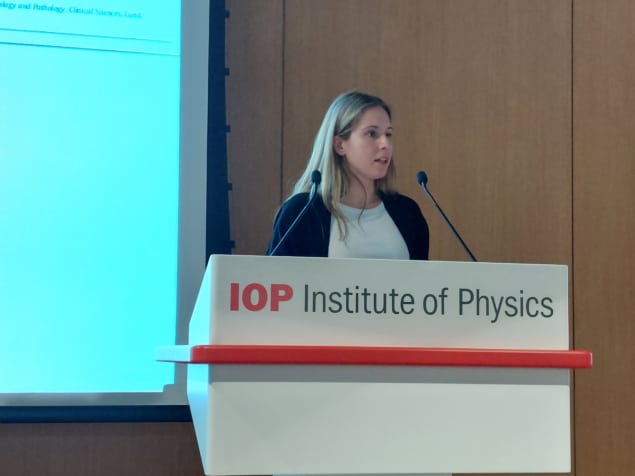Researchers meet up in London to discuss the pipeline for moving FLASH radiotherapy from basic research into the clinic

FLASH radiotherapy – delivery of therapeutic radiation at ultrahigh dose rates – is the subject of much attention from researchers and physicians worldwide. The technique offers potential to spare healthy tissue while still effectively killing cancer cells, but many questions remain as to how the FLASH effect works, how to optimize radiation delivery, and how – and whether – to bring FLASH treatment into the clinic.
Hot on the heels of the FRPT 2022 conference in Barcelona, the Institute of Physics hosted a one-day meeting in London entitled: Ultra-high dose rate: Transforming Radiotherapy in a FLASH? Speakers at the event aimed to answer some of the above questions, and update the audience on the latest FLASH research in the UK.
What do we know?
The first speakers of the day were Bethany Rothwell from the University of Manchester and Mat Lowe from The Christie, who gave an introduction to the concept of FLASH and explained what we currently know, and don’t know, about the technique. “The big question in FLASH is why does the sparing effect happen, what’s the mechanism?” said Rothwell.
Looking at the raft of preclinical studies performed to date – which initially used electron beams, then moved onto protons and photons, and recently even included carbon and helium ions – Rothwell noted that experiments demonstrated different levels of normal tissue sparing, with dose modifying factors ranging between about 1.1 and 1.8, and no tumour modifying effects. Studies also suggest that high doses, of 10 Gy or above, are required to induce FLASH, and that oxygenation plays an important role.

Focusing on proton-based FLASH, Lowe considered some of the practical considerations of clinical translation. “We have conditions for FLASH that we need to meet, but also have clinical requirements to meet,” he explained. He described some of the implications of requiring high dose rates and potentially having a dose threshold to meet.
For pencil-beam scanning, for example, a degrader is used to change the energy of the proton beam; but the resulting scattering and required collimation can impact the delivered dose rate. Lowe pointed out that the FAST-01 trial – the world’s first in-human FLASH clinical trial – used protons in transmission mode (where the beam passes through the patient rather than stopping at the Bragg peak). “We’ve given up some of conformality to maintain a high dose rate,” he explained.
Lowe emphasized that protons are a promising modality for delivering FLASH, as the equipment is already suitable for generating high dose rates. But careful consideration is needed as to whether current planning and delivery approaches are still appropriate. Should FLASH radiotherapy be delivered in fractions, and how many? Could we deliver beams from different directions in each fraction? “We need to build on existing clinical procedures, so we don’t lose existing advantages,” he said. “There’s lots of work to be done.”
Studies with electrons
Kristoffer Petersson told the audience about research underway at the University of Oxford. He also described some of the challenges in bringing FLASH to the clinic – including defining the specific beam parameters needed to induce FLASH and understanding the underlying radiobiological mechanisms – and emphasized the need for more preclinical data.
Towards this goal, the Oxford team is using a dedicated 6 MeV electron linear accelerator, which can deliver electron beams at dose rates from few Gy/min up to several kGy/s, to perform preclinical FLASH experiments. Petersson described some example studies performed on the system, including whole-abdomen irradiation of mice that confirmed FLASH sparing of normal intestinal tissue. Investigating the impact of various parameters on the treatment outcome revealed that while the pulse structure used to deliver FLASH could have an effect, the most important parameter is the average dose rate.
Looking further ahead, Petersson is considering a different approach. “I think that if FLASH is to have a big impact in the clinic, we need to go to megavoltage photon beams,” he said. The team’s current set-up enables FLASH with megavoltage photons, with FLASH dose rates achieved at depths from 0 to 15 mm. A new triode gun installation will enable higher and more flexible output, he noted.
Response monitoring
Other speakers at the meeting included David Fernandez-Antoran from the University of Cambridge, who described an innovative in vitro 3D culture system for analysing short- and long-term responses to FLASH treatment. Known as epithelioids, these 3D cultures can be created from various cells, including cancerous and normal mouse and human epithelial tissues, and can be maintained for year-long time periods. Fernandez-Antoran is working with the team at Manchester University to test the impact of proton FLASH irradiation on the samples.
Anna Subiel and Russell Thomas from the UK’s National Physical Laboratory told the delegates about NPL’s recent development of the world’s first portable primary standard calorimeter for absolute dosimetry of proton beams. Calorimeters benefit from being independent of dose rate and linear with dose in the ultrahigh dose rate range, making them ideally suited to measure high-dose, short-duration dose deliveries such as FLASH. Indeed, as Subiel explained, the NPL primary standard proton calorimeter was successfully used in the FLASH proton beam at Cincinnati Children’s Hospital prior to the start of the FAST-01 clinical trial.
Elise Konradsson from Lund University in Sweden spoke about the use of FLASH radiotherapy to treat pets with spontaneous cancers. “We wanted to validate FLASH in a clinically relevant set-up, so we started a collaboration to treat veterinary patients,” she explained, noting that dogs can be treated with similar radiation qualities and field sizes as humans. She pointed out the dual benefits of this approach: the patients receive advanced diagnostics and treatment, while the researchers gain useful clinical information.

The Lund team is using a modified linac to deliver 10 MeV electron beams at dose rates of more than 400 Gy/s. Konradsson described a dose escalation trial in canine cancer patients, using a single fraction of FLASH, which concluded that the approach was feasible and safe, with response in most patients, and a maximum tolerated dose 35 Gy.
Konradsson also described the use of surface-guided radiotherapy for motion management during FLASH treatment of canine patients. “I really think veterinary patients can help us close the translational gap,” she told the audience.
Into the clinic?
The day concluded with a debate examining whether FLASH is ready for the clinic. The first speaker, Ran Mackay from The Christie, does not think that it is. He told the audience that he had attended FRPT 2022 hoping to understand the mechanisms underlying FLASH – but actually came back with a “top 10” of potential options, ranging from free radical recombination to DNA damage, reactive oxygen species to the effect of local oxygen consumption. “So can you deliver FLASH radiotherapy with all this uncertainty about FLASH mechanisms?” he asked.
While FLASH has been prescribed for patients, including treatment of a single patient with skin cancer and the FAST-01 proton FLASH trial of bone metastases, Mackay noted that “these are fairly safe starting points”.
Mackay argued that currently, it’s not clear how to prescribe a course of effective FLASH radiotherapy and we don’t understand enough about dose rate required to induce FLASH or the key parameters to optimize in a treatment plan. With so many questions remaining, he asked whether we are ready to move to prescriptions that rely on FLASH for normal tissue sparing. “We have to be cautious in how we move forward to broader application of FLASH radiotherapy,” he said.
Another problem is the lack of relevant treatment machines, with no CE marked clinical device for delivering FLASH. “We can only deliver under an investigational device exemption granted in the US for one manufacturer’s proton machines,” said Mackay. He also pointed out that there’s also currently no way to verify FLASH delivery in vivo. “In reality, we deliver a high dose rate and hope to induce FLASH,” he explained. “But there’s nothing in FAST-01 to show evidence we delivered FLASH, we hope that FLASH is being induced, but have no evidence.”

Photons, protons or electrons: which will bring FLASH radiotherapy to the clinic?
Arguing the case that FLASH is ready for the clinic was Ricky Sharma from Varian and University College London, who had earlier told the delegates about the FAST-01 and FAST-02 clinical trials.
Sharma suggested that while we may not know the exact mechanisms underlying FLASH, it may not be a necessity to fully understand this prior to early implementation. Concerns regarding risks to trial patients will be addressed by regulatory bodies, he said, pointing out that clinical trials have already received regulatory approval, and that long-term follow-up is built into these studies. He noted that more than 200 preclinical studies have been published, including peer reviewed papers in high-impact journals. None of these studies showed that FLASH may risk tumour sparing.
“So is FLASH ready for the clinic? I’d argue it is already in the clinic,” Sharma concluded. “Is it ready for CE or FDA approval? No, it’s not. But it is ready for clinical trials, the first steps have already been taken.”
And the audience agreed with Sharma, with a show of hands vote concluding that FLASH indeed is ready for the clinic. A fitting end to a highly informative day.



